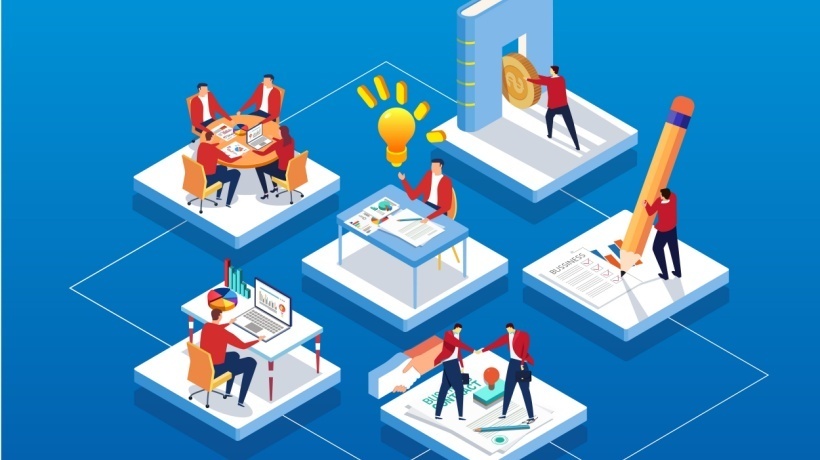Microlearning At Scale: From Training Events To Everyday Learning
Traditional corporate training often meant taking employees "out of work" for structured sessions. But in today's fast-moving business environment, leaders cannot afford productivity slowdowns or knowledge decay. This is where learning in the flow of work—combined with continuous microlearning—emerges as a powerful solution. By embedding bite-sized learning directly into daily workflows, organizations reduce disruption while ensuring employees can adapt in real time. For CEOs and CHROs, the implication is clear: the companies that thrive will be those that make learning not an event, but a habit.
Why Flow-Of-Work Learning Matters
1. Agility In Disruption
Business priorities shift quickly, from regulatory changes to market disruptions. Embedding learning in workflows allows teams to upskill immediately, without waiting for a training cycle.
2. Knowledge Retention
Microlearning leverages spacing and reinforcement. Instead of one-time sessions, employees encounter content in short bursts, improving long-term memory and application.
3. Minimal Productivity Loss
Employees access learning within the tools they already use—CRM, ERP, messaging platforms. Training becomes part of work, not a distraction from it.
4. Continuous Culture Of Growth
When learning is seamlessly integrated, it signals that skill development is everyone's responsibility, every day. This fosters a resilient, adaptable culture.
Microlearning: The Engine Of Flow-Of-Work Learning
Microlearning refers to short, targeted modules—videos, scenarios, quizzes—that can be consumed in under ten minutes. Paired with AI and modern platforms, it allows:
- Rapid updates
Content can be refreshed in days, not months. - Scalability
Thousands of employees can access new skills instantly. - Contextual fit
Learning can be triggered by real tasks—for example, surfacing a compliance reminder when filling a form. - Data-driven adaptation
AI recommends microlearning tailored to role, history, and performance gaps.
Why Leaders Should Care
This is not just an L&D tactic—it's a business lever. Flow-of-work learning directly supports top leadership priorities:
- Innovation
Employees can keep pace with new technologies and markets. - Efficiency
Time spent in training is minimized, reducing opportunity costs. - Compliance and risk
Critical updates (e.g., regulations, cybersecurity) can be delivered instantly, reducing exposure. - Retention
Employees value learning opportunities tied to career growth, boosting engagement and loyalty.
From Theory To Practice: How Companies Apply It
- Retail enterprise
Embeds three-minute microlearning on upselling techniques into point-of-sale systems, improving conversion rates. - Healthcare network
Uses micro-scenarios for front-line staff, reinforcing patient safety protocols within electronic health records systems. - Professional services firm
Deploys weekly microlearning nudges on client management, improving consulting effectiveness and client satisfaction.
The CEO's Role In Driving Flow-Of-Work Learning
To embed continuous learning effectively, executive sponsorship is essential. Leaders can:
- Define strategic learning priorities
Align microlearning with business objectives like digital transformation, compliance, or customer experience. - Invest in integrated platforms
Ensure learning tools embed into existing systems. - Empower managers as coaches
Provide managers with prompts and dashboards to reinforce microlearning in team discussions. - Model the behavior
When executives engage in microlearning themselves, it sets a cultural precedent.
Measuring What Matters
Traditional metrics like course completions miss the point. Instead, leaders should ask:
- Are employees applying what they learn immediately in workflows?
- Do performance indicators (sales, safety, customer satisfaction) improve?
- Are compliance risks reduced?
- Is engagement with microlearning sustained over time?
These metrics connect learning investments directly to business outcomes.
Challenges To Anticipate
- Content relevance
Microlearning must be tightly aligned to tasks; generic content risks disengagement. - Overload
Too many nudges or modules can feel like noise. Balance is key. - Equity
Ensure all roles—including frontline and deskless workers—have equal access. - Manager accountability
Without reinforcement, microlearning remains surface-level. Leaders must hold managers responsible for embedding it into practice.
Human-Centered Design: Keeping Employees Engaged
Even in short bursts, learning must be designed to motivate and resonate. This includes:
- Storytelling
Using realistic scenarios to boost emotional connection. - Interactivity
Short quizzes or choices to drive participation. - Recognition
Badges, shout-outs, or simple "thank yous" from managers. - Autonomy
Allow employees to choose microlearning that aligns with their goals.
Five-Step Road Map For Leaders
- Assess business needs
Identify where rapid upskilling supports strategy. - Embed tools
Integrate microlearning into daily systems and processes. - Curate and create content
Balance internal expertise with external providers. - Reinforce with managers
Equip managers with coaching guides and discussion prompts. - Measure and adapt
Track application and business outcomes, not just participation.
Conclusion: Learning As A Competitive Advantage
Learning in the flow of work and continuous microlearning represent more than efficiency tactics. They redefine how organizations build agility, resilience, and innovation at scale. For C-suite leaders, the imperative is to treat everyday learning as a strategic differentiator. In an environment where disruption is constant, companies that make learning part of the job—rather than apart from it—will be the ones that thrive.








